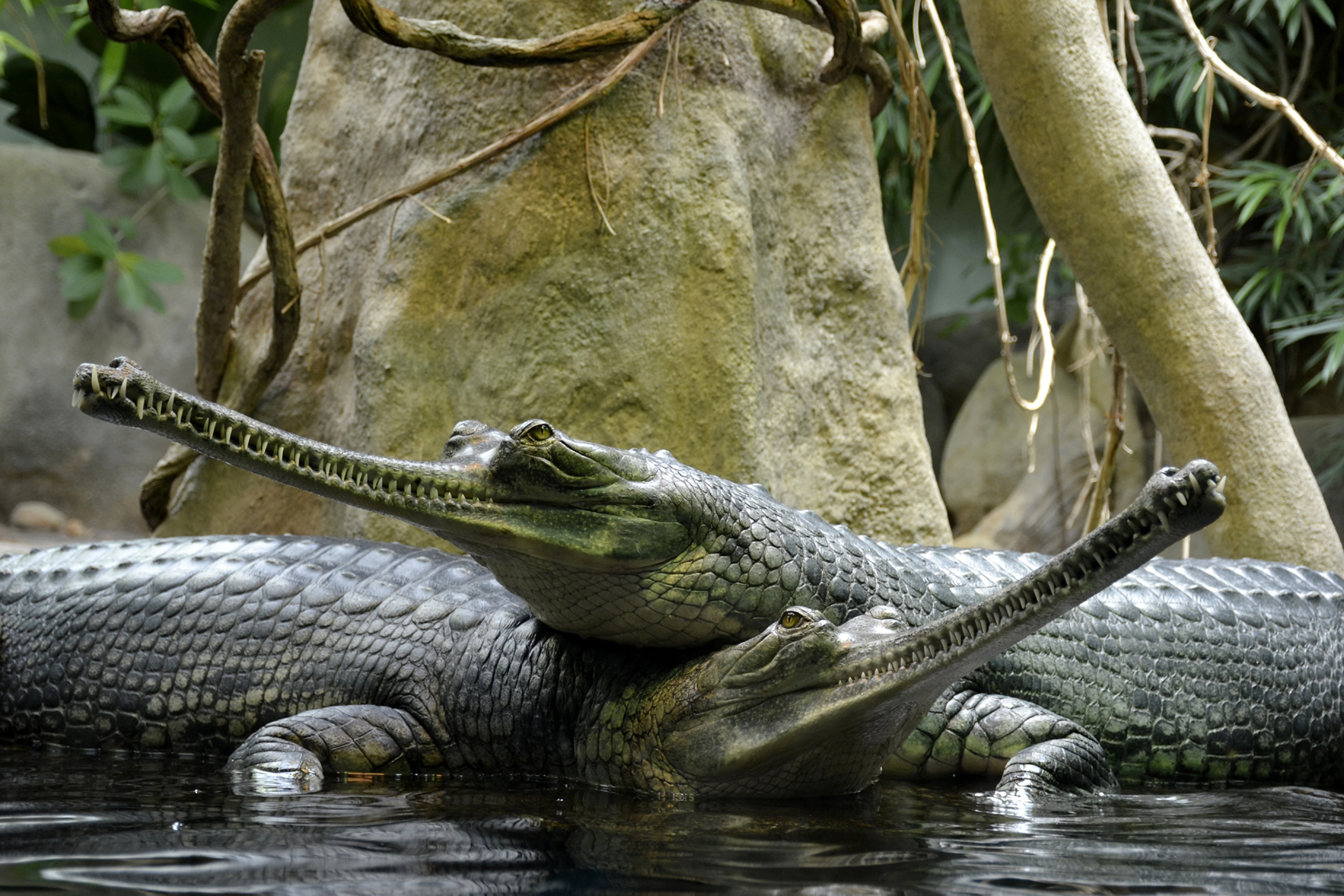Interviews
Phoebe Griffith: Keep an eye on gharials, or they will disappear
Nepal is one of the last remaining countries with a gharial population.-copy.jpg&w=900&height=601)
Thomas Heaton
Phoebe Griffith has spent about a year in Chitwan, studying the critically endangered gharial. These long-snouted crocodiles once thrived all over South Asia but recent times have seen a drastic decline in their populations, placing on the brink of extinction. Due to habitat encroachment and over-fishing of prey, there are currently just an estimated 230 gharials in Nepal.
Griffith, who spent four years of her childhood living in Kathmandu, returned last year as part of her Oxford University Dphil, as part of the Wildlife Conservation Research Unit, to evaluate conservation measures in crocodilians. Thomas Heaton spoke to Griffith about her work with the gharials in Nepal and ongoing conservation efforts. Excerpts:
The following interview has been condensed for clarity.
How did you come to work with gharials in Nepal? Why here, and what are you doing with these animals?
I found out that the Zoological Society of London (ZSL) was starting a project on gharial conservation and there was a call from both the Nepal government and Chitwan National Park staff to do some research on gharials. When I spoke to the international crocodile community, they said there was a need for more research from Nepal.
My general PhD is evaluating conservation measures in crocodilians, with a specific focus on the impact of Nepal’s ongoing gharial conservation strategy. My particular focus is on ‘headstarting’, a method that is widely used on crocodiles, turtles and tortoises because they have high natural mortality—anywhere between 90 and 98 percent won’t make it to adult size. The idea is you collect in a number of eggs from the wild, you rear them to a certain size and release them back into the wild, giving them a headstart in life. Then, it’s about coming up with a complete strategy here in Nepal, which could be applicable to other species as well.
I’m essentially trying to continue the work of Tirtha Man Maskey, who was one of the conservationists killed in a helicopter crash in 2006. He did his PhD in the 80s, on evaluating this headstarting measure on gharials in Nepal. I have that baseline, and now I’m trying to replicate that with modern techniques and modern technology, 40 years on.
What efforts have there been historically, in terms of gharial conservation in Nepal and abroad?
The national parks have done a phenomenal job to keep them around. In 1978, they started the Gharial Breeding Center, with support from the Smithsonian, Frankfurt Zoo, Tiger Tops, Chitwan National Park and the Department of National Parks and Wildlife Conservation . They started collecting gharials from the wild every year. They rear the gharials to over a metre and a half because then they’re pretty safe from any predation in the wild, and they release them every year in February-March. They’ve probably released over 1,500 until now. The focus is in Chitwan where the gharials are released into the Rapti and Narayani rivers under the assumption that they will supplement the population and alleviate mortality. In the 1980s, there were as few as three gharials in the Rapti, but now there are over a hundred [with one sub-male, which is a male that is not fully grown or sexually mature]. But the Narayani, which has two adult males, which has about a hundred also, has not seen an increase in population.
The population downstream in India has been increasing, but conservation efforts there are relatively new. The current theory is that since a lot of these headstarts are swimming downstream to India, they cross the barrage on the border downstream. But once they cross the barrage they are stuck and can’t get back to Nepal. To track the animals, I’m placing radio tags on them. I did 20 releases this year and, hopefully, we will do some more next year.
Gharial populations thrived in South Asia less than a hundred years ago. What were the biggest contributors to this precipitous population decline?
The decline was quite swift. Even in the 40s and 50s, gharials were populus—from west of the Indus basin, through the Indus, Ganges and Brahmaputra, all the way east into Myanmar. By some estimations, they were among the most populous crocodilians in the world. In Nepal, it was reported that every year during the annual winter hunt, when Chitwan National Park was a private hunting ground, the Ranas would come down and kill about 50 gharials a year. By the beginning of the 80s, they were endangered. Nepal and India started conservation programmes but in Bangladesh, Pakistan and Bhutan, it was too late. They are extinct in those countries.
National park officials attributed this decline to the use of illegal gill-net fishing, as gharials get caught in the nets and die.
They started counting dead gharials last July, and including those found in my work, they found 10 sub-adults had been killed in fishing nets. Of a population of 200, that’s not great.

Why are the populations of gharial so localised?
A problem is the building of barrages and dams across waterways in their range. When populations start to dissipate in certain rivers, it tallies up pretty neatly with building dams or barrages. But the impact of fragmented habitats, changing water flow and the altered hydrology needs to be considered equally.
The barrages isolate these populations into discrete units. They should be in every main loading river in Nepal, and they are only in the Rapti, Narayani, and the Babai river in Bardiya—there was breeding this year, which is exciting. The Karnali did have a population once, but the river moved and the hydrology changed, so you can’t really find any gharial there anymore. They were in the Koshi river until recently, but they’re all gone now. Any deep, fast-flowing river in the lowlands, they should be there. But they’re only surviving in places where there’s active conservation.
What is the process for releasing gharials back into the wild, and at what age are they released?
They’re brought up at the breeding centre and they’re all released in the Rapti river. They’re over 1.5 metres when released, but can be a fair bit bigger. National park staff cut off their scutes, the bone plates on the animals back, in a particular pattern and keep a database. Then, they are taken to the river where they create a soft release pen that’s made from elephant grass, half in the water, half out of the water. They spend anything from two days to two weeks there, before forcing their way out through the grass into the river. The idea is that it acclimates them to the flow of the river in a safe and contained environment. In one instance, we had one that forced through on her first day, but the others all stayed longer.
What are the gharial’s major predators?
Humans are the problem. Natural predation is predominantly for the young, as anything will eat the hatchlings—from storks and big fish to mugger crocodiles. The population of muggers is quite high but the number of natural predation events is quite low. If the gharials and muggers have coexisted for their entire evolution, that can’t be the problem. There have also been anecdotal reports of tigers killing gharials, but it is the people—changing rivers, killing with fishing nets, and historical poaching—that continue to compromise their survival.
How important are gharials to their ecosystem?
They start fishing at about two weeks and they’re very reliant on mahseer [sahar], which are migratory fish, so they are also at risk because of the dams. If the mahseer populations are dying, gharials will probably be close behind. Gharials are also known to eat softshell turtles, especially the big ones. While they feed on all kinds of fishes, the decline in the number of mahseer has become a problem. Gharials are top predators. They’re really important in regulating populations. Just as tigers keep the number of deer in check, gharials serve that purpose when it comes to fish. When there are no longer apex predators, it creates a trophic cascade—an ecological phenomenon triggered by the addition or removal of top predators. This results in a much less diverse, much less healthy ecosystem.
In the Narayani and Rapti systems, you have three apex predators: mugger crocodiles, gharials and Asiatic river dolphins. With the dolphins gone, one species is already lost. So the role of gharials is probably an important one.
Chitwan National Park started a monitoring programme for wild gharials last year, has it yielded any results? If yes, what do they say?
The ZSL-initiated programme is coordinated by the National Trust for Nature Conservation, so they do a census every February. That census will hopefully give an idea of the number of gharials—the number of adults, sub-adults and whether the population is increasing or decreasing. My project is doing the post-release monitoring, looking specifically at what is happening with each of these gharials.
Hopefully, if the gharials last two years, they stand a pretty good chance. We’ve got permission to catch 15 gharials this November, so if we recatch any previous releases, we will be able to report on whether they’re breeding or not. If they are, that’s the gold standard in headstart programmes.
***
What do you think?
Dear reader, we’d like to hear from you. We regularly publish letters to the editor on contemporary issues or direct responses to something the Post has recently published. Please send your letters to [email protected] with "Letter to the Editor" in the subject line. Please include your name, location, and a contact address so one of our editors can reach out to you.




 8.12°C Kathmandu
8.12°C Kathmandu












